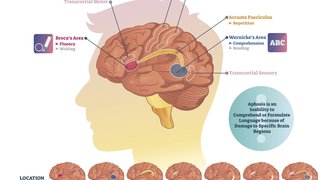
No two people experience migraines the same way. People with migraine suffer symptoms beyond severe headache, including vision changes, nausea, and sensitivity to sound and light.
Likewise, a treatment that works for one person may not work for another, and some people need to take more than one approach. We’re not completely sure of the exact cause of migraines, although it could be related to abnormal brain activity, genetics, or environmental factors. Thankfully, we have more treatment options today than ever before.
Two of these emerging treatments for frequent migraines are getting a lot of attention right now: neuromodulator devices and therapies targeting calcitonin gene-related peptide (CGRP), which are related to the cascade of events that occur during a migraine.
1. Neuromodulation devices
It sounds futuristic: Hold a device up to your head and a pulse of electric or magnetic stimulation targets the nerves involved in a migraine. But this is exactly how neuromodulation therapy works.
Most neuromodulators were originally developed to treat migraines once they started, but we’re finding out that when used regularly, they may also have a preventive effect. It’s sort of like training the brain to fight migraines.
My patients especially seem to like these noninvasive devices because they’re not a drug or injection, and they have few, if any, side effects. They can be used in conjunction with medication or in lieu of it. One population who may really benefit from neuromodulators are pregnant women, because there are so many medications they can’t safely take.
We currently use two neuromodulation devices – supraorbital nerve stimulation and transcranial magnetic stimulation (TMS) – and a third is pending Food and Drug Administration (FDA) approval.
Supraorbital nerve stimulation
This device, marketed under the name Cefaly, is a triangular-shaped adhesive electrode that is placed on the forehead for 20 minutes a day. You control the intensity of the micropulses, which are sent to the trigeminal nerve, the largest nerve inside the skull that controls sensation in the face and motor functions such as chewing. The pulses create a slight tingling before the forehead goes numb. Cefaly also is approved for the acute treatment of migraine.
A small study in 2013 found that 38 percent of participants who used Cefaly for 20 minutes daily over three months had at least a 50 percent reduction in migraine frequency. The control group had only a 12 percent reduction in migration frequency. The Cefaly group also was able to reduce migraine drug intake by 36 percent.
Cefaly is a prescription device that patients must buy, and the up-front cost of $350 or more turns some people off. However, if you use it instead of medication, it may cost less in the long run. Check with your insurance company to see if it will cover all or part of the cost, including a pack of electrodes and shipping.
Transcranial magnetic stimulation
The SpringTMS is a handheld device that uses magnets to deliver a pulse of electrical energy to the back of the head. It stops cortical spreading depression, a process in which nerve cells start firing in the back of the brain, travel forward, and then go quiet. This wave of nerve firing and tapering off causes the visual aura some people with migraines experience.
TMS originally was tested and used for patients whose migraines were accompanied by visual auras, but is also helps patients without aura.
We recommend giving two pulses at the beginning of a migraine attack and then every 15 minutes as needed. You won’t feel anything when you use the TMS device, but it does make some noise. Some patients who’ve used TMS daily have seen their migraine frequency reduced over time.
This is a prescription device that you rent. Check with your insurance company to see if it will cover all or part of the cost.
Vagus nerve stimulation
The gammaCore device is FDA-approved for the treatment of migraine attacks. It is also used for the acute treatment of episodic cluster headaches. The device is about the size of a mobile phone with two round heads that transmit the stimulation. It is used to stimulate the cervical branch of the vagus nerve in the neck.
VNS captured researchers’ imaginations as a migraine treatment after epilepsy patients who had the device surgically implanted reported fewer migraines along with a reduction in seizure frequency.
A 2015 study of this noninvasive device found that half of patients using a VNS device reported at least a 50 percent reduction in pain, with nearly 40 percent being pain-free. It also was effective in patients with chronic migraine.
2. Therapies targeting CGRP
Every migraine therapy we currently use was originally designed to treat another condition: epilepsy, depression, high blood pressure, etc. But we discovered by accident that they also help prevent and relieve migraines.
Therapies targeting calcitonin gene-related peptide (CGRP) are the first designed specifically to prevent and relieve migraines. CGRP causes blood vessels to dilate and it is released as part of the migraine process. Studies have found people who get migraines have increased CGRP levels compared to people who don’t get them. Additionally, when CGRP is injected in migraine patients, it triggers a migraine. It causes a milder, non-migraine headache when injected in people who do not get migraines.
These treatments are being tested in clinical trials, and the results are promising. They are expected to be approved by the FDA in 2018.
There are two main approaches to CGRP-targeting treatments:
- Monoclonal antibody therapies: Four companies are currently testing antibodies that block the CGRP receptor or bind to CGRP to neutralize it. Three of these therapies are administered through subcutaneous injections (just beneath the skin) and one through IV infusion. All are designed to prevent migraines. They are also being tested for cluster headache prevention.
- CGRP inhibitor: This new class of oral medications that block CGRP is designed to treat migraines once they start.
One common class of currently used migraine medication, triptans, causes blood vessels to constrict, which can be dangerous for people with heart disease. The CGRP therapies, however, don’t cause constriction of the blood vessels and can be used by people who can’t take triptans.
Overall, this is an exciting time for migraine patients and doctors. As advances continue to be made in understanding and treating migraines, we’re hopeful that we will be able to better prevent and more quickly relieve migraine pain. Talk to your doctor about treatment options for your migraines.
Editor’s note: In this story, migraine refers to the condition. Migraines refers to the subsequent headache and related symptoms.










